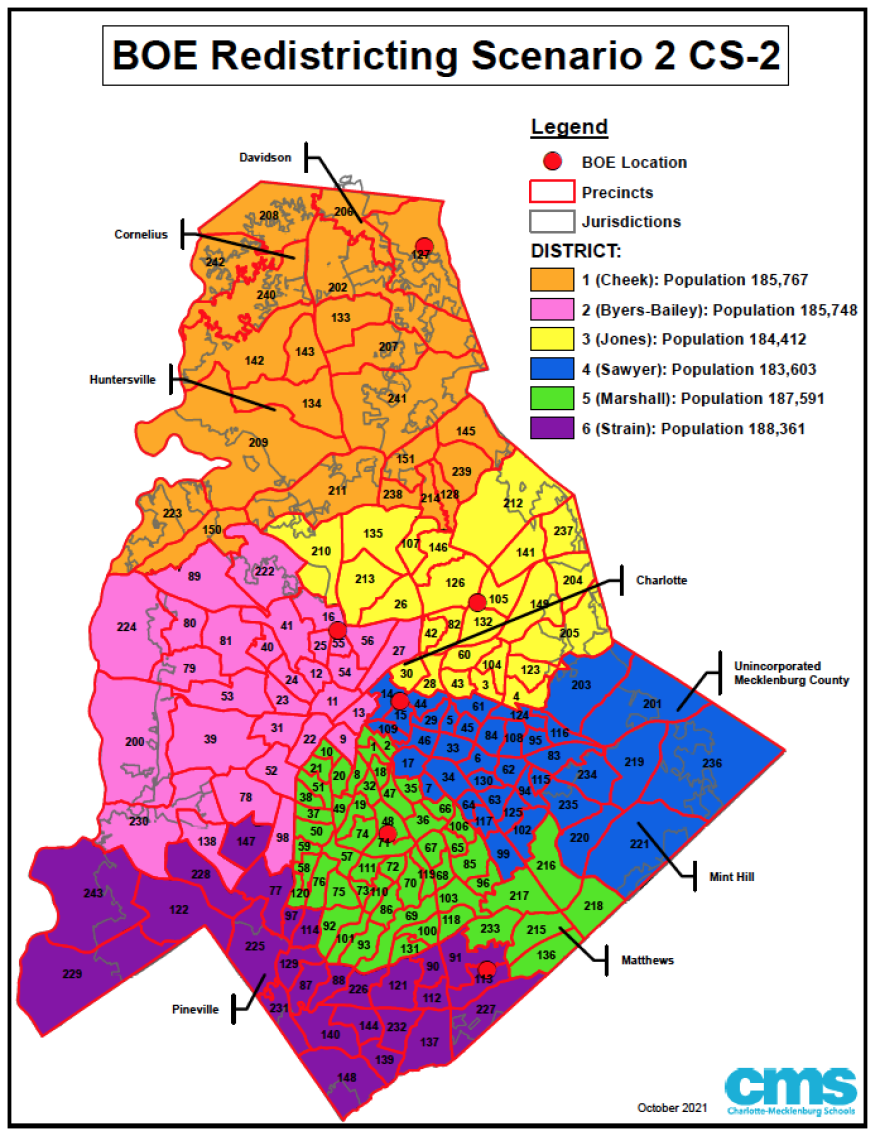The Charlotte-Mecklenburg school board will vote Tuesday on new districts to elect six of the board's nine members.
Unlike Mecklenburg County commissioners, who approved a new map that is very similar to the current one, the school board is looking at two options that make significant changes.
The school board is trying to balance population based on delayed 2020 census data, while creating compact, contiguous districts that won't pit current incumbents against each other. The new electoral boundaries will move thousands of residents into new school board districts.

Here's what the two new maps do:
District 1
The northern District 1, which Rhonda Cheek has represented for the past 12 years, currently encompasses more than 191,000 residents and needs to get smaller. The two options on the table are similar, with one reducing the district to almost 181,000 residents and the other adding a precinct that would bring it to almost 186,000.
District 2
The west/southwestern District 2, represented by Vice Chair Thelma Byers-Bailey, is the most oversized district with more than 206,000 residents. Both scenarios carve off the fast-growing southwestern tip of Mecklenburg County, moving some of those precincts into District 6.
One scenario takes a smaller slice off the southwestern edge, while the other moves more southern precincts into District 6 and extends District 2 eastward into central Charlotte.
District 3

The east/central District 3, represented by Ruby Jones, currently has more than 191,000 residents and needs to shrink.
One map removes some precincts along the north and western edge of the district and adds some on the southern edge, bringing the population to just over 187,000. The other keeps more of the western part of District 2 intact but redraws other boundaries, for a total population of about 184,000.
District 4
The east Charlotte District 4, represented by Carol Sawyer, is the smallest district with almost 171,000 residents. One plan adds several central Charlotte precincts to the district, while shifting some on the northern part of the district into District 3. The population ends up at about 185,000.
The other plan adds districts in southeast Mecklenburg County, including Mint Hill, to give District 4 almost 184,000 residents.

District 5
The south/central District 5, represented by Margaret Marshall, has almost 175,000 residents and needs to grow. One plan extends the district south into what's now District 6, creating a district with about 180,000 residents.
The other extends District 5 southeast to the county line, taking in Matthews. It ends up with almost 188,000 residents.
District 6
The current district, represented by Sean Strain, looks like a check mark running along the county's south/southeastern edge. It includes Pineville, Matthews and Mint Hill and has just over 181,000 residents.
One plan creates a long, narrow District 6 that runs along the county's southern boundary from southwest to southeast. It would continue to include all three suburban towns and have a population of almost 193,000 — well above the target of 185,000 for new districts.
The other shifts the district west, moving Matthews and Mint Hill into other districts. That version has about 188,000 residents.
Next election in 2022
The school board will hold a public hearing before voting on new districts Tuesday night. No one spoke at last month's public hearing on three proposals drawn up by staff.
CMS board members are elected to four-year terms, and the six district representative would normally have faced election last week. A delay in 2020 census data postponed that election to next year. The three at-large members will be up for election in 2023.



